The best bowling aids for cerebral palsy athletes include adjustable ramps, lightweight (1-5 pound) balls with specialized grips, switch-activated launchers, custom wrist supports, guide rails with sensory feedback, digital positioning systems, foam/rubber balls for varied grip strengths, customizable handle attachments, portable practice aids, and thumb release stabilizers. These adaptive tools considerably improve control, stability, and independence while reducing strain and frustration. Discover how these innovations can transform your bowling experience and boost your confidence on the lanes.
Adjustable Bowling Ramps for Athletes With Limited Upper Body Mobility
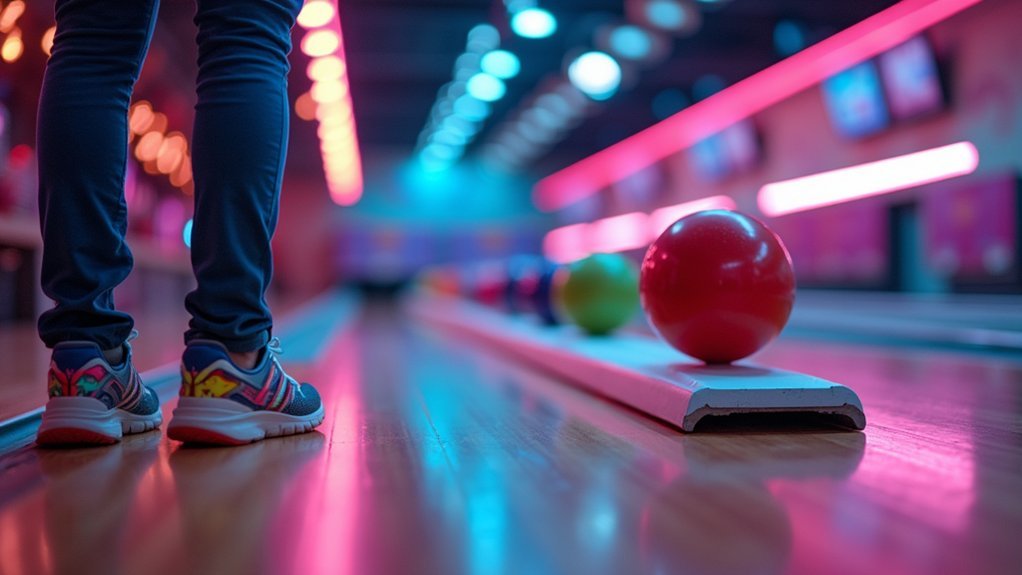
When physical limitations prevent traditional bowling techniques, adjustable bowling ramps become essential tools for athletes with cerebral palsy. These durable steel or aluminum devices offer stability while remaining portable enough for use in various locations.
You’ll find options that extend to waist height, eliminating the need to bend and increasing independence. Many include rubber pads to protect floors and enhance safety during use. The ability to control elevation reduces back strain while guide rails improve ball alignment and control.
Waist-height ramps offer independence while rubber pads and adjustable guides ensure safety, comfort, and accuracy for every bowler.
What makes these ramps particularly valuable is their adaptability. You can easily integrate them with other aids like ball pushers and wrist supports to match your specific needs. Products like the POSS-I-BOWL 2000 kit specifically benefit individuals who can stand but have disabilities affecting traditional bowling methods.
Their straightforward assembly also means you won’t struggle with setup or transportation between bowling sessions.
Light-Weight Bowling Balls With Specialized Grips
While assistive devices like ramps help athletes position their shot, the equipment you’re actually rolling makes a significant difference too. Light-weight bowling balls weighing just 1-5 pounds can dramatically reduce strain and improve control for cerebral palsy athletes.
You’ll find various grip options designed specifically for limited hand strength. Textured surfaces provide better traction, while ergonomic indents fit naturally in your hand. Some models feature retractable handles or adjustable straps that eliminate the need for a firm grip during release. Modern designs are comparable to the standard 1.5kg bowls used in competitive CP Bowls.
These customizable balls offer more than just physical benefits. As you use them consistently, you’ll likely notice improvements in hand-eye coordination and muscle control.
The ability to participate independently builds confidence and creates opportunities for social engagement with family members and peers.
Switch-Activated Ball Launching Devices for Independent Play
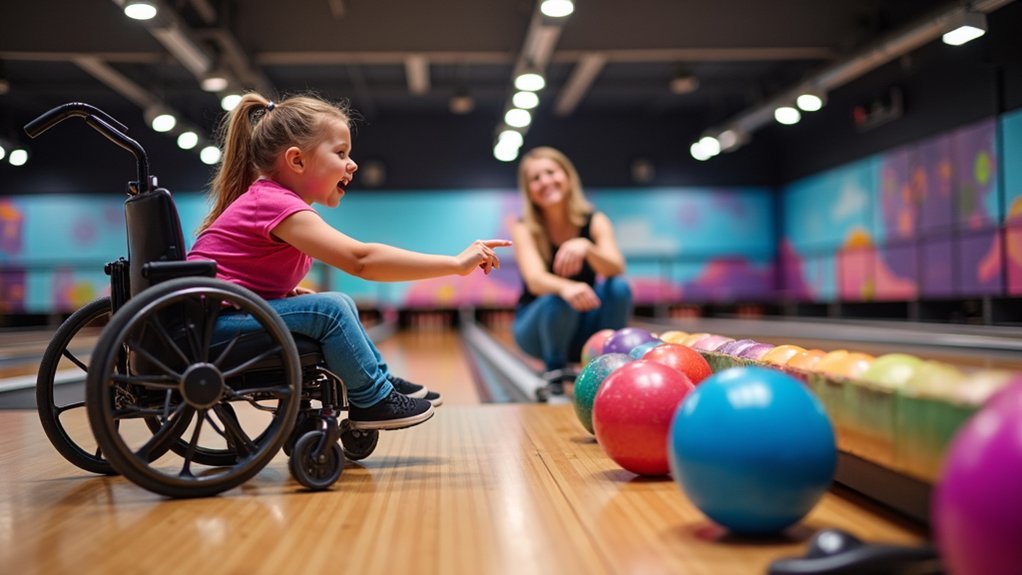
You’ll find switch-activated ball launching devices offer unprecedented control options for bowling, from adjustable speed settings to customizable launch directions.
These technological marvels transform the bowling experience by allowing you to operate the device through accessible switches positioned where you have the most reliable movement. Similar to the adapted Nerf tennis shooter designed for Harry Flynn, these devices incorporate 3D printed parts to enhance functionality for users with limited strength.
Your freedom through technology isn’t just about participating in the game—it’s about making independent choices that reflect your personal playing style and preferences.
Control Options Matter
Four essential control options have revolutionized how athletes with cerebral palsy engage in bowling independently.
You’ll find these adaptations promote both skill development and social inclusion while maintaining the fun of the game.
- Accessibility switches enable players with limited mobility to control ball launchers with minimal physical effort, teaching cause-and-effect relationships.
- Joystick controls provide precision aiming capabilities, allowing users to direct their shots without requiring fine motor skills.
- Wheelchair-integrated systems connect directly to assistive equipment, creating a seamless bowling experience without transferring from support devices.
- 3D-printed custom adaptations offer personalized solutions tailored to your specific needs and abilities, ensuring the most comfortable and effective bowling experience.
These technological innovations aren’t just practical—they’re motivation tools that encourage independence through play. Many electric ball pushers feature button activation capabilities that make them ideal for athletes who use power wheelchairs.
Freedom Through Technology
Switch-activated ball launching devices represent the cornerstone of freedom and independence for cerebral palsy athletes in bowling. These innovative systems feature large, colorful buttons that you can operate through accessibility switches, enabling genuine autonomous play.
You’ll find these devices can be seamlessly integrated with your wheelchair using specialized mounts and joystick controls, similar to other adaptive sports equipment. This technology not only facilitates bowling but contributes to therapeutic goals by improving hand-eye coordination.
The impact extends beyond physical benefits—you’ll experience enhanced social inclusion as you participate in group activities, building confidence with each successful frame. CanAssist’s success with their Indoor Ball Launcher technology demonstrates how effectively these devices support cause-and-effect learning while providing independent play opportunities.
Organizations frequently collaborate with schools and engineers to customize solutions through 3D printing and electrical innovations, ensuring the technology precisely matches your unique needs and abilities.
Custom Wrist Supports for Enhanced Control and Stability
You’ll find spring-loaded wrist braces particularly helpful for managing involuntary movements while maintaining proper form during your bowling release.
Thumb release stabilizers can dramatically improve your grip control and provide consistent finger positioning even when muscle tone fluctuates.
Adjustable tension supports offer you the flexibility to customize pressure levels based on your specific cerebral palsy symptoms, allowing for greater independence as your needs change throughout a bowling session. The C4 Wrist Brace provides excellent control with its adjustable cup and lateral wrist angle features that can be tailored precisely to your unique hand positioning needs.
Spring-Loaded Wrist Braces
Spring-loaded wrist braces represent a significant advancement in adaptive bowling equipment for athletes with cerebral palsy.
These customizable devices provide mechanical assistance that stabilizes your wrist while helping manage spasticity during your bowling motion. Designed similarly to the SaeboFlex dynamic splint, these braces enable individuals with neurological impairments to incorporate functional movement in both therapy and recreational activities.
You’ll benefit from:
- Adjustable tension springs that can be customized to match your specific support needs
- Enhanced wrist extension support that promotes proper hand positioning for improved ball control
- Adaptable design that can be modified for different bowling techniques and styles
- Specialized padding for comfort during extended bowling sessions
Unlike ramps or ball pushers that assist with direction, these braces focus on improving your physical ability to bowl by providing stability at the wrist joint while allowing natural movement within your comfort range.
Thumb Release Stabilizers
Designed specifically for bowlers with cerebral palsy, thumb release stabilizers provide essential support where you need it most—at the critical moment of ball release.
These specialized devices enhance thumb control and consistency, allowing for smoother bowling motions despite coordination challenges.
You’ll find custom wrist supports can be tailored to your unique needs using materials like neoprene or nylon for comfort during extended play.
They maintain ideal wrist and thumb alignment, greatly improving your control throughout the bowling motion.
For athletes with hemiplegic cerebral palsy, thumb web spacer splints can complement these stabilizers by maintaining functional thumb position.
You can integrate these supports with other adaptive equipment like ramps or guides, creating a thorough solution that enhances both performance and enjoyment of the sport.
The stabilizers effectively prevent wrist injuries while providing the necessary support for cerebral palsy athletes to achieve better ball control.
Adjustable Tension Supports
Adjustable tension supports take wrist stabilization to another level, offering customizable options that complement thumb release systems.
These durable supports help maintain proper wrist position during your bowling motion, reducing strain while providing stability when releasing the ball. Social inclusion efforts highlighted in the BCES Conference show how adaptive equipment can significantly improve participation opportunities for athletes with disabilities.
You’ll benefit from these key advantages:
- Customizable fit – Velcro straps and adjustable tension mechanisms adapt to your specific needs
- Injury prevention – Consistent support reduces pressure on your wrist during repeated throws
- Enhanced performance – Stable wrist position leads to more accurate ball delivery and control
- Versatility – Compatible with other adaptive equipment like ramps and specialized balls
Whether you prefer neoprene for comfort, leather for durability, or metal-reinforced options for maximum stability, you’ll find these supports notably improve your bowling experience and confidence.
Guide Rails With Sensory Feedback for Accurate Alignment
Guide rails with sensory feedback represent a notable advancement in adaptive bowling equipment for cerebral palsy athletes. These rails provide precise alignment assistance, helping you position correctly for each throw.
The integration of tactile and auditory cues offers real-time feedback, enhancing your ability to aim accurately despite visual or motor challenges. When combined with bumper installation, these systems effectively prevent gutter balls while still providing an authentic bowling experience.
You’ll find these rails are typically constructed from durable yet lightweight materials, making them portable across different venues. Their adjustability lets you customize the setup based on your specific needs and bowling style.
By reducing frustration and improving accuracy, these guide rails not only make bowling more accessible but also offer therapeutic benefits through increased physical activity.
The confidence gained from successful throws using these aids can notably enhance your overall bowling experience and social participation.
Wheelchair-Compatible Bowling Platforms and Approaches
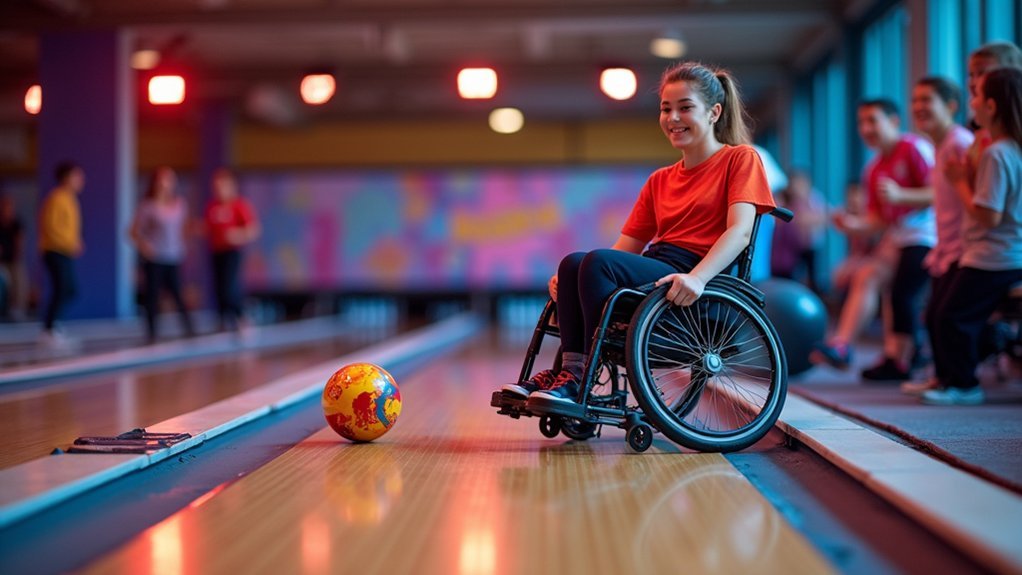
Wheelchair-compatible bowling platforms have revolutionized the sport for cerebral palsy athletes by eliminating physical barriers that once limited participation.
These specialized approaches feature wide arched bases that accommodate wheelchairs and scooters, allowing you to position yourself properly for the perfect release.
When utilizing these accessible platforms, you’ll benefit from:
- Easy maneuverability – The design allows you to wheel directly up to the approach without awkward transfers.
- Minimal physical effort – Ramps guide the ball with reduced exertion requirements.
- Social inclusion – You can participate fully alongside friends and family during recreational outings.
- Therapeutic value – Regular bowling practice improves motor skills while providing enjoyable recreation.
These platforms promote independence and confidence in athletes with cerebral palsy, similar to how other assistive devices enhance self-sufficiency in daily activities.
Consider making advance reservations at accessible lanes to minimize wait times, especially during busy periods.
Smart Bowling Equipment With Digital Positioning Assistance
While accessible platforms provide physical advantages, the technological revolution in bowling has created smart equipment that offers unprecedented precision for cerebral palsy athletes.
These innovations help overcome coordination challenges through digital guidance systems.
The B.O.L.T.S (Ball On Lane Tracking System) utilizes four high-speed cameras to analyze your ball’s path with remarkable accuracy. This technology provides immediate feedback on trajectory, speed, and spin, allowing you to make precise adjustments suited to your abilities. The system tracks data at 60 frames per second, gathering 80-120 data points for each shot.
Instant digital analysis transforms every throw into a learning opportunity for cerebral palsy athletes seeking bowling precision.
You’ll find these smart systems particularly valuable as they can identify ideal release positions based on your specific mobility range.
Some advanced equipment even includes haptic feedback to guide your movements or visual prompts that simplify targeting.
These technological aids effectively transform bowling into a more inclusive sport where cerebral palsy athletes can compete with enhanced confidence.
Foam and Rubber Balls for Athletes With Varying Grip Strengths
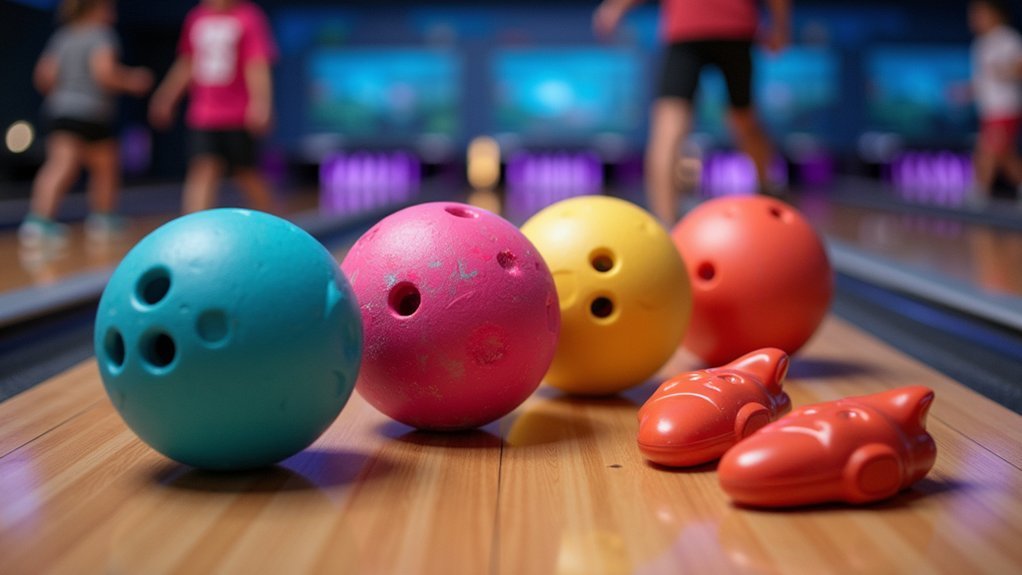
For athletes with cerebral palsy who struggle with conventional bowling balls, foam and rubber alternatives offer a game-changing solution.
These lightweight options typically range from 1-5 pounds, making them accessible for players with different grip strengths and dexterity levels.
- Enhanced Grip – The soft texture of foam balls and tactile surface of rubber balls provide better control with less hand strain.
- Adaptable Weight Options – Choose between ultra-light foam or slightly heavier rubber based on individual capabilities.
- Compatibility – Work seamlessly with ramps, bumpers, and other adaptive equipment.
- Sensory Benefits – The different textures offer sensory integration advantages while improving the overall bowling experience. Equipment like the Zip Zap Zoom Ball can complement bowling practice by developing bilateral coordination needed for consistent throws.
You’ll find these adaptive balls promote inclusion while allowing participation in mainstream bowling activities.
Customizable Handle Attachments for Improved Ball Release
Customizable handle attachments represent another major advancement in adaptive bowling technology, complementing the foam and rubber balls previously discussed. These ergonomic aids greatly enhance grip control and wrist alignment, allowing you to achieve more precise ball releases while preventing injuries. Proper tools like universal cuffs can be integrated with these attachments to provide additional support for athletes with unique needs.
| Attachment Type | Key Benefit | Best For |
|---|---|---|
| Retractable Handles | Self-retracting mechanism | Athletes with limited release timing |
| Grip Sleeves | Additional stability | Those with weak hand muscles |
| Wrist Supports | Maintains ideal position | Athletes prone to wrist strain |
| Thermal Grips | Temperature-neutral surface | Sensory-sensitive bowlers |
You’ll find these attachments work seamlessly with other adaptive equipment like ramps and guide rails. The adjustable straps accommodate various hand sizes, while lightweight materials promote comfort throughout your bowling session. Many athletes report increased confidence and independence when using these customized solutions.
Portable Bowling Aids for Practice and Competition Settings
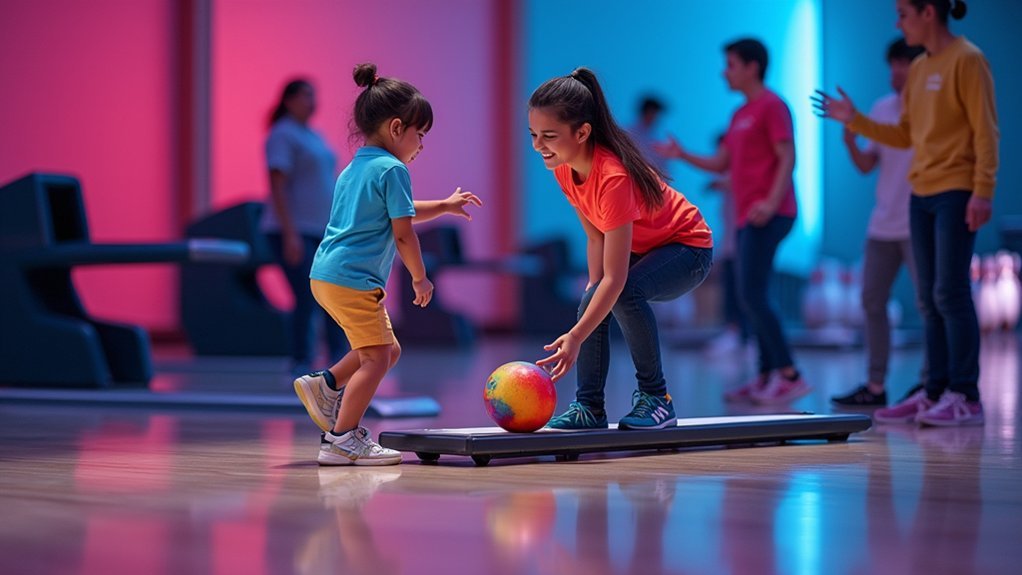
Portable bowling aids have revolutionized how athletes with cerebral palsy can practice and compete in various settings beyond specialized facilities.
These lightweight, transportable systems combine stability with convenience, allowing you to bowl almost anywhere.
You’ll find these aids especially valuable because they:
- Include electronic control systems with precision release mechanisms that operate on standard 9-volt batteries
- Feature secure wheelchair attachments that maintain safety while preventing unwanted movement during use
- Offer adaptability between home practice lanes and competitive environments without complex setup
- Provide independence through controlled release systems like the POSS-I-BOWL that require just a gentle touch
Companies like Innovative Products Inc. in Grand Forks are dedicated to creating mobility devices that enhance the quality of life for individuals with disabilities.
These portable solutions don’t just improve accessibility—they enhance skill development while fostering greater participation in both casual and competitive bowling.
Frequently Asked Questions
Can Bowling Aids Be Used in Official Paralympic Competitions?
Yes, you can use bowling aids in Paralympic competitions, but they must be authorized by governing bodies like World Bowling and the IPC, and must comply with technical specifications for your specific classification.
What Funding Options Exist for Purchasing Adaptive Bowling Equipment?
You can secure funding for adaptive bowling equipment through organizations like High Fives Foundation, Challenged Athletes Foundation, and Move United. Apply during their specific grant cycles, typically requiring proof of disability and need.
How Do I Determine Which Bowling Aid Matches My Specific CP Symptoms?
Consult with physical therapists to assess your mobility, strength, and motor control. Try different aids in person when possible. Consider how your CP affects grip, balance, and coordination before selecting equipment that enhances your abilities.
Are There Bowling Leagues Specifically for Cerebral Palsy Athletes?
While there aren’t many leagues exclusively for cerebral palsy athletes, you’ll find opportunities through Special Olympics, adaptive sports organizations, and inclusive community programs that welcome participants with various disabilities, including CP.
At What Age Can Children With Cerebral Palsy Start Using Bowling Aids?
Children with cerebral palsy can typically start using bowling aids around age 3-5, depending on their individual motor skills. You’ll want to assess your child’s ability to understand instructions and engage with the equipment first.
In Summary
You’ll find that these 10 bowling aids can transform your cerebral palsy athlete’s experience on the lanes. They’re designed to accommodate different mobility levels while promoting independence and confidence. Whether you’re coaching or supporting an athlete, don’t hesitate to try several options to find what works best. Remember, the right equipment doesn’t just improve performance—it makes bowling more enjoyable for everyone.





Leave a Reply